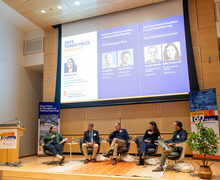Why some films score with reviews but not the box office
Courtesy of Warner Bros.
“Blade Runner 2049,” one of the most anticipated releases of the year, follows a young blade runner tracking down Rick Deckard, a former blade runner who's been missing for 30 years.
Ryan Gosling, Harrison Ford, a follow-up plot to one of the most successful sci-fi cult films of all time and rave reviews didn’t make the cut to save “Blade Runner 2049” at the box office.
It’s no argument that filmmaking is an art — a lucrative, expensive art that can cost upward of $100 million and employ thousands of skilled craftsmen, camerapersons, actors, cinematographers and producers. But because so much money is on the line, quality art is often sacrificed in the name of cash grabbers.
That’s why you have a “Transformers” franchise raking in millions while the original films often slip silently by.
Unfortunately, the rulers of the film world are not artists — they’re capitalists. They fund artists hoping to cash in on their creativity and skills. But they often restrict creativity in favor of the safe route: the white male hero gets the girl, the bad guys are defeated or reformed and there’s a computer-generated imagery explosion every five minutes.
But sometimes the investment is there, and the filmmaker’s creativity is still welcome to run free. Such was the case with “Blade Runner 2049.” The sequel to the 1982 film was released in early October and was one of the most anticipated releases of the year.
With an approximate combined production and advertising budget of $300 million, distributor Warner Bros. Pictures had high hopes to recoup its investment. Response to the film was phenomenal. The Atlantic claimed it was a “worthy heir to one of the greatest science-fiction films of all time.”
But despite the great reviews, “Blade Runner 2049” undershot its projected $50 million+ opening weekend, bringing in only $31.5 million. Had the film not cost a few hundred million, that wouldn’t be such a bad thing.
But the well-reviewed sequel with star power to boot didn’t translate into a financial breadwinner.
“It should come as no surprise that we see a disconnect between critical reviews and box office sales for new film releases,” said Imraan Farukhi, a Syracuse University television, radio and film professor.
Some studios would disagree. This past summer, total box office revenue was down 15 percent from summer 2016. Studio executives point the blame finger toward the growing emphasis on critic reviews, particularly those aggregated on the website Rotten Tomatoes. The website essentially intakes hundreds of critics’ reviews and classifies them as either positive, or “fresh,” or negative, “rotten.”
With big budget films such as “Transformers: The Last Knight” and “Pirates of the Caribbean: Dead Men Tell No Tales,” all scoring under 30 percent on the “Tomatometer” and underperforming at the domestic box office, it’s no wonder execs try to place the blame elsewhere.
But just as rotten labels can be a deterrent, fresh labels are a mark of confidence. “Baby Driver” is the perfect example. Strong reviews and word-of-mouth gave the film’s box office earnings an incredible boost, and ads were actually reworked to include the “Certified Fresh” logo.
The logo is such a mark of confidence that designers of posters, trailers and DVD packaging now adjust colors and layouts to showcase the logo properly.
Correlation does not always imply causation, and several well-reviewed films released in the last few months have still struggled to rake in a profit.
“Logan Lucky,” is another example in a similar boat. The film sports an impressive 93 percent on the Tomatometer, a high-profile cast including Channing Tatum and the elusive Daniel Craig and a director whose previous films include the “Ocean’s” trilogy and “Magic Mike.” On a $29 million budget, “Logan Lucky” made only $27.7 million stateside.
“Critics are known to praise films that are thought-provoking and which typically require a greater level of patience to watch,” Farukhi said. “(But) audiences now want the flexibility to click in-and-out of what they view at home. As a result, audiences have lost patience.”
This disconnect between what popular audiences want and what critics want is not new. The gap is widening thanks to the growing demand for instantaneous viewing.
Movies started out as a spectacle, a reason to get out of the house and be transported to a world that was not our own for a few hours. Soon they evolved from technical novelties into moving and awe-inspiring works of art, intended to be seen as largely and loudly as possible. By skipping theater-going for tablet-watching, audiences are doing a disservice to filmmakers and their craft.
Take a few hours out of your week and give yourself the chance to escape from reality for a bit. With a discounted ticket in one hand and extra-buttered popcorn in the other, take the critics’ advice: Go see “Blade Runner 2049.” Go see a movie on the big screen.
Lilly Stuecklen is a senior television, radio and film major. Her column appears weekly in Pulp. She can be reached on Twitter @Stuecks or by email at lsstueck@syr.edu.
Published on October 25, 2017 at 1:02 am





